
The Four Thirds System is a standard created by Olympus and Eastman Kodak for digital single-lens reflex camera (DSLR) and mirrorless camera design and development.

Macro photography is extreme close-up photography, usually of very small subjects and living organisms like insects, in which the size of the subject in the photograph is greater than life size . By the original definition, a macro photograph is one in which the size of the subject on the negative or image sensor is life size or greater. In some senses, however, it refers to a finished photograph of a subject that is greater than life size.
A kit lens is a "starter" lens which can be sold with an interchangeable-lens camera such as a single-lens reflex camera. It is generally an inexpensive lens priced at the lowest end of the manufacturer's range so as to not add much to a camera kit's price. The kit consists of the camera body, the lens, and various accessories usually necessary to get started in SLR photography. A kit lens can be sold by itself outside of a kit, particularly the ones that are moderately expensive; for instance a kit lens included in a prosumer SLR kit is often marketed as an upgrade lens for a consumer SLR. In addition, retailers often have promotions of standalone low-end SLR bodies without the lens, or a package that bundles the SLR body with one or two more expensive lenses.
The Olympus OM System was a line of 35mm single-lens reflex cameras, lenses and accessories sold by Olympus between 1972 and 2002. The system was introduced by Olympus in 1972. The range was designed by Yoshihisa Maitani, chief designer for Olympus, and his staff; OM stands for Olympus Maitani.

The Olympus E-3 was until 2010 Olympus Corporation's flagship camera, positioned as a professional DSLR camera. It is the successor to the Olympus E-1, which was launched in November 2003. The E-3, originally codenamed Olympus E-P1, was announced on 17 October 2007. The E-3, like the other cameras in the Olympus E-series, conforms to the Four Thirds system. It was succeeded in 2010 by the Olympus E-5 professional DSLR flagship camera.

The Micro Four Thirds system is a standard released by Olympus and Panasonic in 2008, for the design and development of mirrorless interchangeable lens digital cameras, camcorders and lenses. Camera bodies are available from Blackmagic, DJI, JVC, Kodak, Olympus, Panasonic, Sharp, and Xiaomi. MFT lenses are produced by Cosina Voigtländer, DJI, Kowa, Kodak, Mitakon, Olympus, Panasonic, Samyang, Sharp, Sigma, SLR Magic, Tamron, Tokina, TTArtisan, Veydra, Xiaomi, Laowa, Yongnuo, Zonlai, Lensbaby, Kowa, Venus Optics and 7artisans amongst others.
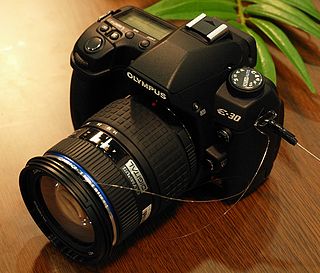
The Zuiko Digital 14–54 mm f/2.8–3.5 II is a Four Thirds System Pro series lens by Olympus Corporation, sold in a kit with the Olympus E-30 camera body and available separately. It is positioned just below the Olympus Zuiko Digital ED 12–60mm 1:2.8–4 SWD in terms of size, weight, focusing speed, price and focal length range, while having larger apertures. It replaces the Olympus Zuiko Digital 14–54mm 1:2.8–3.5, which had a longer minimum focusing distance.

A pancake lens is colloquial term for a flat, thin camera lens assembly. The majority are a prime lens of normal or slightly wider angle of view. Some are zoom lenses.
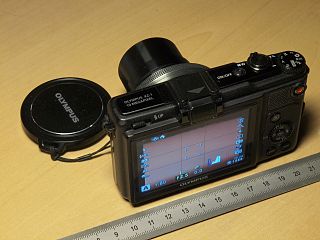
The Olympus XZ-1 is a high-end 10.0 megapixel compact digital camera announced and released in January 2011. Its key features are a fast f/1.8-2.5 i.Zuiko Digital lens, a built in imager shift image stabilizer and Olympus' 6 Art Filters that are also present in the E-PEN series.
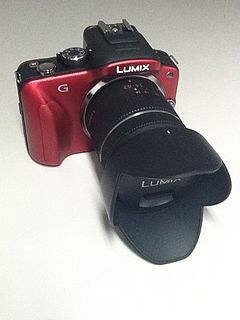
The Panasonic Lumix DMC-G3 is a digital mirrorless interchangeable lens camera adhering to the joint Olympus and Panasonic Micro Four Thirds System (MFT) system design standard. The Panasonic Lumix DMC-G3 is the eighth Panasonic MFT camera introduced under the standard and the thirteenth model MFT camera introduced by either Olympus or Panasonic, as of the G3 product announcement date.

The Panasonic Lumix DMC-G2 is a digital mirrorless interchangeable lens camera adhering to the Olympus and Panasonic developed Micro Four Thirds System (MFT) system design standard. It was announced in March 2010 along with a lesser featured Panasonic Lumix DMC-G10.
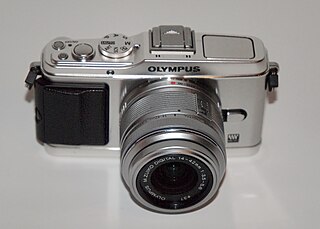
The Olympus PEN E-P3 announced on 30 June 2011 is Olympus Corporation's seventh camera that adheres to the Micro Four Thirds (MFT) system design standard. The E-P3 succeeds the Olympus PEN E-P2, and was announced in concert with two other models, the Olympus PEN E-PL3, and the Olympus PEN E-PM1.

The Zuiko Digital 25mm f/2.8 is a Four Thirds System standard-series lens manufactured by Olympus, sold both separately and bundled in a kit with the E-420 camera.
Zuiko is a brand of optical lenses made by Olympus Corporation that was used up to and into the Four Thirds system era. The name Zuiko (瑞光) means 'Light of the Gods', using a character from the Mizuho Optic Research Laboratory (瑞穂光学研究所), where the lens was developed, and a character from Takachiho Corporation (高千穂製作所), which would eventually become the Olympus Corporation.
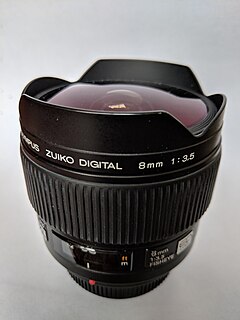
The Olympus Zuiko Digital ED 8mm f/3.5 Fisheye is an interchangeable "full-frame" or diagonal fisheye lens for Four Thirds system digital single-lens reflex cameras, announced by Olympus Corporation on June 30, 2005.
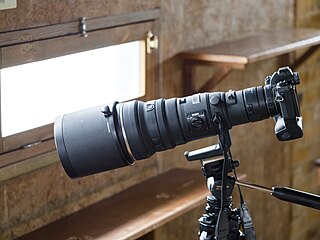
The Olympus Zuiko Digital 300mm 1:2.8 is an interchangeable camera lens announced by Olympus Corporation on June 24, 2003. As the largest and heaviest lens in the Zuiko Digital line, the ZD300mm f/2.8 was given the nickname "Big Tuna".
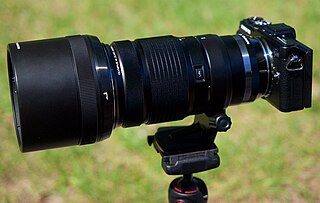
The M.Zuiko Digital ED 40–150mm f/2.8 PRO is a professional telephoto zoom lens made by Olympus for the Micro Four Thirds system. It is the first telephoto lens in the Olympus M.Zuiko PRO range, which features weather-sealed, metal construction and high-performance optics intended to accompany the higher-end weather-sealed Olympus OM-D bodies such as the E-M1 Mark II. The lens features an integrated lens function button and manual-focus clutch, and ships with a tripod collar and collapsible lens hood.
Olympus M.Zuiko Digital ED 8 mm f/1.8 Fisheye Pro is an optically corrected fisheye lens.

Olympus M.Zuiko Digital ED 300 mm f/4 IS Pro is an optically corrected telephoto lens. With its extreme focal length of 300 millimetres it is the refracting prime lens with the longest focal length of the Micro Four Thirds system.

The Zuiko Digital 14–54 mm f/2.8–3.5 is a Four Thirds System High Grade series lens by Olympus Corporation, initially sold in a kit with the Olympus E-1 camera body and also available separately. Three glass aspherical lenses are used in its optical formulation. It was positioned as an upgrade to the 14-45mm kit lens in terms of focal length range while having larger apertures. It was replaced as the premium kit lens by the Olympus Zuiko Digital ED 12-60mm f/2.8-4 SWD with the release of the E-3, and later was directly replaced by the Olympus Zuiko Digital 14-54mm f/2.8-3.5 II, which is more suited for mirror-up or mirrorless operation.
















